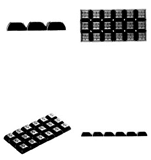The Schogetten chocolate cases from Germany and Hungary are an example of how differently courts in the member states can still interpret what is essentially the same trademark.
This blog deals with the Schogetten chocolate case in Germany (Higher Regional Court Cologne, 15 August 2014 – 6 U 9/14) and Hungary (Fővárosi Törvényszék – 2015. január 21. – 3.Pk.23.764/2014/7). Both cases, which were subjects of previous blogs here and here, concerned the 3D trademarks of Ludwig Schokolade GmbH & Co. KG (German TM no. 39504819 and Hungarian TM no.) 944650 for the brand Schogetten. While the German case dealt with the scope of protection of the shape mark in an infringement case,
the Hungarian case assessed the validity of the mark in an invalidity action started before the Hungarian Intellectual Property Office.
It is interesting to see how the Metropolitan Tribunal characterized the essential features of the shape of the chocolate when assessing the validity of the mark. First the tribunal established that “nature and the technical result to be obtained by it (chocolate) lie in the fact of whether it is consumable”. Then the tribunal said the following on all three essential features: (1) the shape of the chocolate cubes with a smooth surface, no edges and a domed shape performs this function in itself ensuring that it can be easily placed into the mouth, even by children; (2) the cubes placed side by side, corresponding to the layout of the trademark, make it unnecessary to split the blocks or bars as is commonly done with chocolate products by breaking or cutting, which is a favourable solution in hygienic and aesthetic terms; (3) without question, the ‘star’ ornament influences the overall impression, which however does not have any technical function, it merely plays an aesthetic role. That is to say the Metropolitan Tribunal only found validity for the shape mark, because the ‘star’ ornament was added to the functional shape. As explained in a previous post, all essential features must fall within the same exclusion clause in order for the trademark to be invalid. One should think then that the scope of protection only extends to those parts which are non-functional, thus to the ‘star’ ornament.
On the other hand, the Higher Regional Court Cologne found that the scope of protection of the Schogetten shape mark was not limited to the ‘star’ ornament but comprised the shape as such. When the court compared the conflicting signs in terms of visual similarity, the only difference that was to be found was the lack of ‘star’ ornament on the accused product. Contrary to the defendant – and said above by the Metropolitan Tribunal – the German court found that the ‘star’ ornament did not characterize the overall impression, because as a rule the average consumer perceived the mark in as whole and did not pay attention to details.
One may pose the question how the imperfect recollection of the average consumer in the validity test is influenced by the ‘star’ ornament, while in the infringement test it has “barely any relevance”.
In EU design law the principle of reciprocity is applied, meaning that what stands on validity side, stands also on the scope of protection side. This blogger considers that courts should be cautious about overprotecting shape marks, therefore when characterizing their scope of protection they should take into account arguments potentially coming up in an invalidity action. Although the average consumer perceives a shape mark in whole and is not going to assess all of its features, it is familiar with basic shapes (cube for chocolate). In the author’s view, more weight should have been given to the ‘strar’ ornament in the German infringement case, as the Higher Regional Court Cologne did.
The author calls for discussion on whether principles from different intellectual property law regime can be applied in another, even though their purpose and functions are different.
Adam György LL.M. IP (MIPLC)
_____________________________
To make sure you do not miss out on regular updates from the Kluwer Trademark Blog, please subscribe here.




